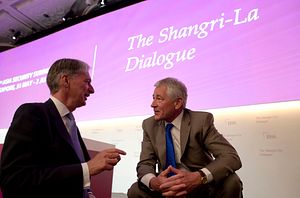There is a difference between dialogue and debate and between debate and quarrel. Unfortunately, the 2014 Shangri-La Dialogues was not a real dialogue, but rather a quarrel between generals and ministers. It also became a media show where Chinese, Japanese, and Vietnamese state media tallied the scores of their delegates, like a boxing match. It is true that the Shangri-La Dialogue has become more and more famous, with participatory countries fighting for speaking slots and the media fighting for opportunities. While its popularity may be good for the media and the Shangri-La Dialogue’s sponsor, the International Institute for Strategic Studies (IISS), this kind of boxing match is not helpful for relations in the Asia-Pacific.
There is no doubt that countries in the Asia-Pacific need dialogue. With rising maritime tensions, dialogue is an essential and safe way for preventing and managing tensions and conflicts. Also the Asia-Pacific region lacks a regional framework like Europe. Prior to the inaugural Shangri-La Dialogue meeting in 2002, the only track one multilateral security forum in the region was the ASEAN Regional Forum (ARF), which was mainly attended by foreign ministers and did not focus on defense and security. So the Shangri-La Dialogue’s rapid development and popularity indicates the need for such dialogue in the region.
Based on IISS’s website, the purpose of the Shangri-La Dialogue is to use dialogue to improve confidence building and foster practical security cooperation. They also hope that this summit serves to cultivate a sense of community among important policymakers and defense officials in the region. Where effective dialogues help confidence and trust building, mutual and open criticism and quarreling is harmful to such efforts. Furthermore, the whole region is currently full of suspicion and distrust, with many tensions boosted by misunderstandings and misperceptions. The degree of quarreling at this year’s Shangri-La Dialogue stirred more negative perceptions and furthered already existing suspicions between countries. For example, Chinese Lt. Gen. Wang Guanzhong said openly that he believed U.S. Defense Secretary Chuck Hagel and Japanese Prime Minister Shinzo Abe coordinated their speeches prior to the summit.
High level participation from China since 2007 has been considered a major breakthrough for the Shangri-La Dialogue. Given that China is a focus of security concern, any security forum is incomplete without high-level Chinese participation. In recent years, China’s participation, especially the PLA generals’ behavior during the meetings, has become the focus of the Shangri-La Dialogue to the point that Beijing may reconsider its participation after this year’s summit. Some Chinese bloggers said on websites and social media that they believed such participation was not in China’s best interests. For example, some were unhappy that Prime Minister Abe was this year’s keynote speaker and that the Lt. Gen. Wang’s (China’s highest ranking delegation member) speech was given on the second day. Some bloggers suggested that China stop sending delegations to the Shangri-La Dialogue, partly because Western media took advantage of the Chinese generals’ being cumbersome to make a news story. Also some were unhappy that Western media focused on how the Chinese delegation expressed itself instead of the content of the speeches.
Under the current situation, I would recommend that the IISS consider reforming the format, agenda, and cohort of delegates for the Dialogue. Basically, the Shangri-La Dialogue should return to being a real dialogue. The purpose of this dialogue is peace-making rather than media exposure. The Asia-Pacific region needs a dialogue forum, but under the current situation of high suspicion and mistrust these meetings and dialogues would be better to be conducted in a closed-door setting. Considering the rise of nationalism in this region and the media’s role in this process, conducting dialogues in front of members of the press can easily transform the talks into a boxing match. Also, knowing their speeches will be viewed by their people at home, generals and ministers would speak to their domestic audiences first rather than communicating with their counterparts from the regional countries. They had no choice but to “talk tough.”
Over the past 30 years, analytic problem solving workshops (APSWs), sustained dialogue programs, and other interactive conflict resolution techniques have been practiced in many of the world’s “hot spots” — from Northern Ireland and the Balkans to the Middle East and Afghanistan. However, the application of conflict resolution practices and theories in the Asia-Pacific region is still uncommon. For the purpose of improving the effectiveness of dialogue, especially when the involved parties lack trust, the IISS should consider introducing new formats and techniques to the Shangri-La Dialogue.
Serving peace is not easy. Often it is harder to seek dialogue and understanding in front of the press and video cameras. Peacemaking requires a lot of quiet efforts made by various parties.
Zheng Wang is the Director of the Center for Peace and Conflict Studies at Seton Hall University and a Global Fellow at the Woodrow Wilson Center.

































